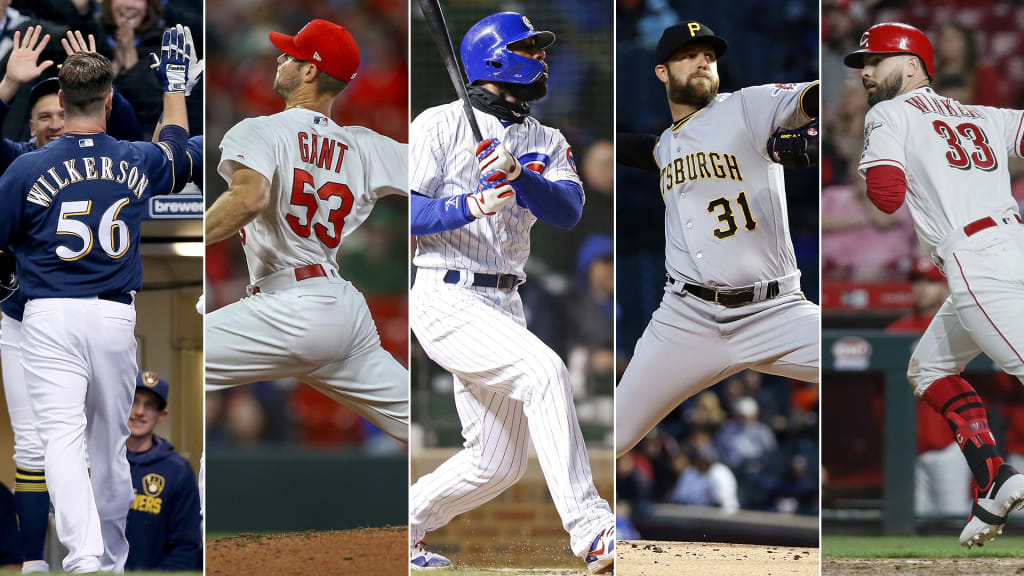
Everyone knows the big players who must be reckoned with on the five teams in the National League Central.
It’s common knowledge, for example, that Josh Hader throws gas and Christian Yelich can rake for the Brewers; that Joey Votto is prolific at reaching base and Luis Castillo has a filthy changeup for the Reds; that Paul Goldschmidt has big power while Jordan Hicks has a power arm for the Cardinals. No one can take Kris Bryant or Kyle Hendricks lightly with the Cubs, nor should Josh Bell or Jameson Taillon ever be overlooked on the Pirates.
But to get ahead and ultimately claim the ultra-competitive NL Central title this season, it will take more than the main guys or obvious answers to solve the riddle. There could be an element of surprise from a lesser known player or skill set that will help one club rise to the top.
Here is a look at some of the potential secrets weapons on the teams in the NL Central:
Brewers: Pitchers wield the bats
Milwaukee’s hurlers can hit. Through their first 32 at-bats, Brewers pitchers were batting a collective .375 with a better OPS (1.022) than 27 of the 30 Major League teams’ third basemen and better than 14 American League teams’ designated hitters. And those figures didn’t include a pinch-hit double for Brandon Woodruff, who’s the best of the bunch, and proved it when he homered off Clayton Kershaw in last year’s National League Championship Series. On Wednesday, Aaron Wilkerson delivered a two-run homer vs. the Cardinals.
The Brewers view this not as a quirk, but as a legitimate advantage, even if it just means regularly turning over the lineup to Lorenzo Cain and Yelich.
Cardinals: Shutdown middle relief
For all the attention paid to Hicks’ triple-digit sinker and Andrew Miller’s All-Star track record, the anchor of the Cardinals’ bullpen during the first month of the season has been its middle. It’s a group that includes one pitcher (John Gant) who couldn’t win a spot in the rotation, another (John Brebbia) whom the Cards discovered pitching in the the independent leagues, and a third (Dominic Leone) who spent nearly four months on the injured list last season.
The three have combined for a 1.05 ERA over 34 1/3 innings while walking 17 and striking out 33. They’ve been credited with four of the Cardinals’ 10 wins and have been critical in providing a bridge to the back end of the 'pen for a team that is averaging less than five innings per start. With the Cardinals only recently adding a second lefty to their bullpen, the success these three righty relievers have had in holding left-handed batters in check has also been key.
Cubs: Opposite-field approach
During Spring Training, the Cubs focused on improvements with situational hitting. That included finding the right moments to take an opposite-field approach, including with two strikes. Per Statcast, Chicago went the opposite way on 25.6 percent of balls in play and 28.6 percent of the time with two strikes in 2018. Through Wednesday, the Cubs had increased those rates to 29.2 percent on all balls in play and 31.2 percent with two strikes. The early results from a lineup that "broke" down the stretch last year have been extremely promising in this area.
Entering Thursday's play, the Cubs' slugging percentage to the opposite field was first in the Majors at .693 (compared to a .495 MLB average). With two strikes, the opposite-field slugging percentage was an MLB-high .796 (compared to .450 for MLB as a whole).
Pirates: RHP Jordan Lyles
Lyles has been in the Majors since 2011, but what makes him a “secret” weapon is the potential the Pirates believe he began unlocking in the Brewers bullpen last season. This year, he has continued to increase the usage of his four-seam fastball (38.3 percent) and a revamped curveball that’s become a really effective pitch over the last couple years (32.3 percent), while also leaning on a changeup (13.2 percent) against which opponents are batting .100 with a 46.2% whiff rate. He’s cut way back on his sinker/slider usage compared to earlier in his career.
Pittsburgh signed Lyles in the offseason to be its No. 5 starter and essentially replace Ivan Nova. When general manager Neal Huntington announced the deal, he talked about helping Lyles “continue to bridge the gap between potential and performance.”
Lyles has allowed one run with 12 strikeouts in 11 innings over his first two starts, so they’re on the right track.
Reds: Winker’s oppo power
Despite his superb plate discipline and ability to get on base, a knock on Jesse Winker as he rose through the Minor Leagues was that the lefty hitter lacked power.
During his first big league callup in 2017, he hit seven home runs -- all of which were pulled to right field. Last season, while still considered a rookie, his power seemed to be taking hold until right shoulder surgery ended his season in July. Not only that, but Winker started flashing opposite-field power, with three of his seven homers going the other way.
So far this season, all four of Winker’s homers have been hit to the opposite field, with three of them either tying a game or giving Cincinnati a lead. Of his 23 career doubles, 12 have been hit to left field or center field.
“Power to all fields is the goal,” Winker said. “I’m trying to stay inside the ball and drive it into the air, really. If it gets up and gets out to left field, perfect.”


